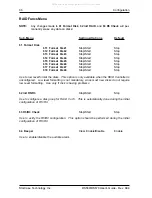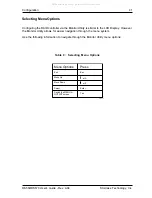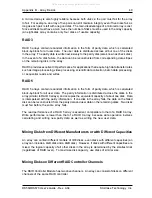
DS560/DS570 User's Guide - Rev. A04
StorCase Technology, Inc.
Appendix B - Array Basics
49
A mirrored array is also highly reliable, because
both disks in the pair
must fail for the array
to fail. For example, an array of five pairs can still maintain integrity even if five disks fail, as
long as each pair is left with one good disk. The main disadvantage of a mirrored array is cost.
Since all disks must have a twin, twice the number of disks must be used in the array capacity
(an eight-disk array contains only four disks of usable capacity).
RAID 3
RAID 3 arrays contain redundant information in the form of parity data, which is calculated
block-by-block for all user data. The user data is distributed across all but one of the disks
in the array. The parity data is written exclusively to the parity disk (also known as check disk).
In the event of a disk failure, the data can be reconstructed from corresponding data stripes
on the remaining disk in the array.
RAID 3 provides excellent I/O performance for applications that require high data transfer rates
such as image processing, video processing, scientific data collection, batch data processing,
or sequential reads and writes.
RAID 5
RAID 5 arrays contain redundant information in the form of parity data, which is calculated
block-by-block for all user data. The parity information is distributed across the disks in the
array (similar to RAID 0 arrays) and occupies the equivalent capacity of about one disk. Data
is interspersed with the parity information. If one disk in the array fails, the data on the failed
disk can be reconstructed from the parity data and user data on the remaining disks. Two disks
must fail before the entire array fails.
The read performance of a RAID 5 array is excellent, comparable to that of a RAID 0 array.
Write performance is lower than that of a RAID 0 array, because write operation involves
calculating and writing new parity data as well as writing the new user data.
Mixing Disks from Different Manufacturers or with Different Capacities
An array can contain different models of IDE disks, even disks with different capacities (an
array can include a 4GB disk and a 9GB disk). However, if disks with different capacities are
mixed, the logical capacity of all other disks in the array is determined by the smallest disk
(regardless of RAID level). To maximize disk capacity, use disks of similar size.
Mixing Disks on Different RAID Controller Channels
The RAID Controller Module has two drive channels. An array can consist of disks on different
channels of the same RAID controller.
All manuals and user guides at all-guides.com










































